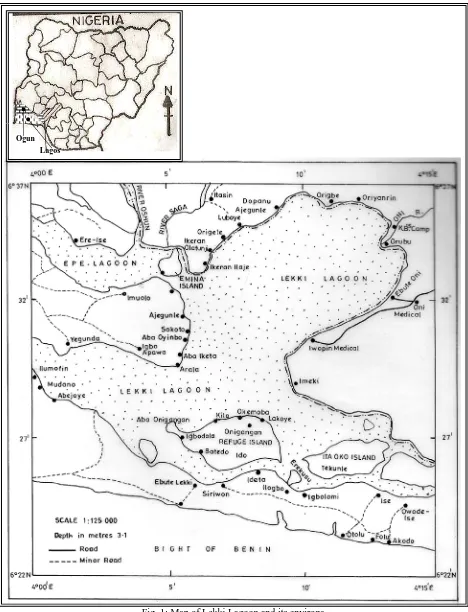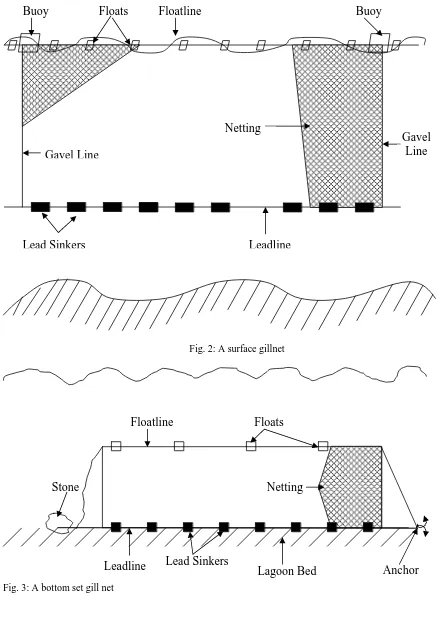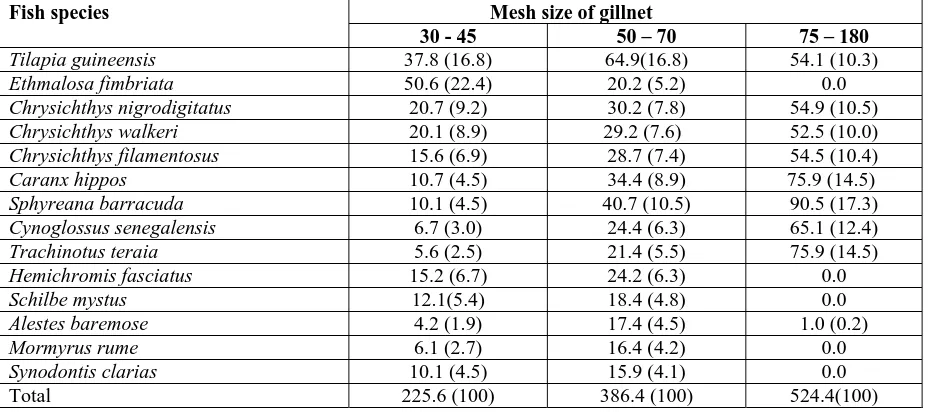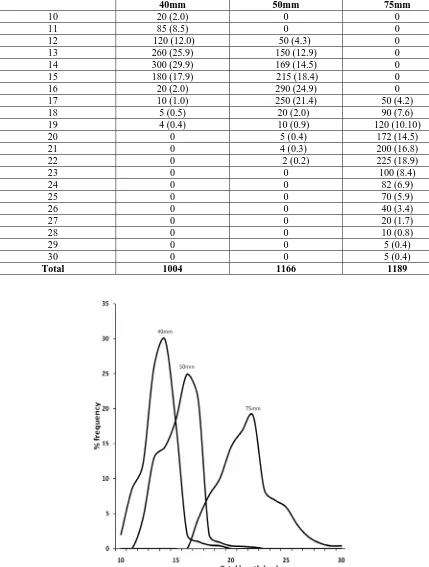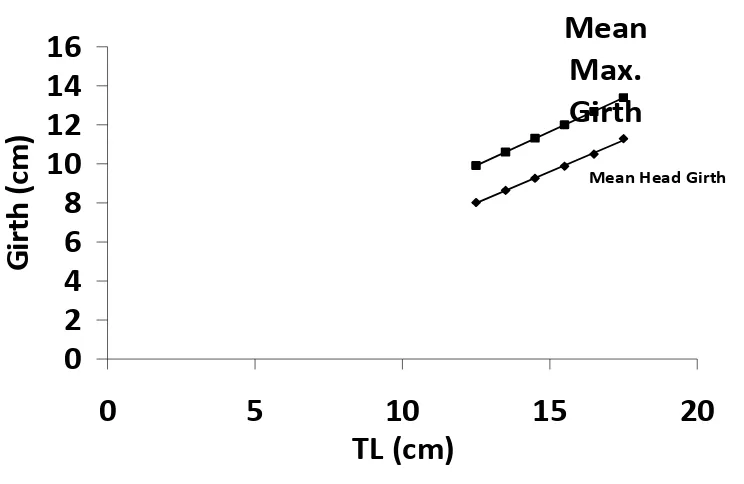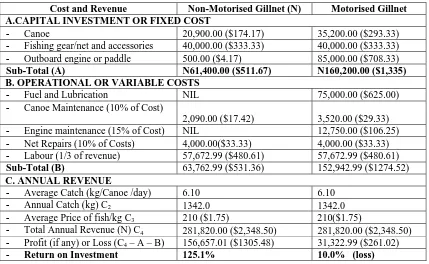Evaluating the selective performance of gillnets used in a tropical
low brackish lagoon south – western, Nigeria.
Emmanuel, Babatunde Eniola 1* and Chukwu, Lucian Obinna1 1Department of Marine Sciences, Faculty of Science,
University of Lagos, Akoka – Yaba, Lagos. monetemi@yahoo.com
Abstract: The result of the investigations of evaluating the selective performance, aspect of design and operation of gillnet used in Lekki lagoon between March, 2006 and February, 2008. The gillnet was the most abundant and constituted 50.04% and 48.74% of the fishing gears in the Lekki lagoon for March 2006 to February 2007 and March 2007 to February 2008 respectively. It was estimated that the 514 gillnet canoes produced a total of 218.73t fish at a low rate of 0.43t canoe/year. The catch per unit effort (CPUE) (kg/canoe/month) range between 14.2kg and 23.0kg with a mean value of 18.9± 2.91. The 30 – 45mm, 50 – 70mm and 75 – 180mm gillnet sizes caught an average of 2.05kg, 2.19kg and 2.32kg fish per canoe per day respectively. Monofilament gillnets caught more fish (by weight) than multifilament gillnets. The performance of gillnet was positively influenced by the improvised poles and concrete sinkers. To provide an overall (aggregated) effect of gillnet on the fish assemblage, multi – species selection curve for 40mm, 50mm and 75mm showed mean retention length of 135mm, 170mm and 235mm respectively. [Journal of American Science 2010;6(1):49-52]. (ISSN: 1545-1003).
Keywords: Gillnet, selectivity, catch per unit effort, slippers, concrete sinkers.
Introduction
Gillnets are used extensively by the small – scale artisanal fishermen in the fresh, brackish and coastal waters of Nigeria (Solarin and Kusemiju, 2003; Emmanuel et al., 2008b; Emmanuel, 2009). Emmanuel et al. (2008b) stated that gillnet is a large wall of netting vertically hanging in the water. Hamley (1975) observed that the design characteristics of the rectangular curtain of netting influenced the performance of the net. Udolisa and Solarin (1979) gave detailed technical features of gillnets in the Lagos lagoon.
The knowledge of the size – selectivity of fishing gear types is crucial to fisheries management and ecology (Emmanuel et al., 2008b). The gillnet selectivity of most tropical lagoon fish is poorly known (Emmanuel et al. 2008b) and the knowledge of the size selectivity of fishing gear types is crucial to fisheries management in order to maximize a sustainable yield (Millar and Holst, 1997; Huse et al., 2000; Emmanuel et al., 2008a; Emmanuel et al., 2008b).
Millar and Fryer (1999) recently clarified the conceptual of fishing gear selection processes and detailed the statistical framework to assess and obtain unbiased results in size – selectivity experiments. Estimates of gear selectivity by age and length – based population models are well documented in industrial fisheries and used for estimating stock size and establishing management measures directed to reduce by – catch and discards (ICES, 1996; Caddy, 1999). However, the selective performance of fishing gears
used in small – scale fisheries has been scarcely documented (Erzini et al., 1996; Stergiou et al., 1996; Stergiou and Erzini, 2002; Emmanuel et al., 2008b) particularly in tropical estuaries. The proper interpretation of survey data is relevant in such fisheries, which have an overwhelming social value as sources of both food and income for local fishers (Blaber, 1997). These multi – species and multi – fleet fisheries are generally open – access with low operating costs, which make fish resources more susceptible to over fishing (Rueda, 2007). In this setting, one critical point to improve management requires considerable technical changes to the gear to increase its selectivity (Caddy and Cochrane, 2001).
Past reports on the uses of gillnet in Nigeria include those of Reed et al, (1967), FAO (1969), Solarin and Udolisa (1979), Solarin (1998), Emmanuel et al (2008b) and Emmanuel (2009). Based on the statistical frame work developed by Millar and Fryer (1999) and following further developments by Zuur et al (2001) and Rueda (2007), this paper assesses the selection processes affecting catch efficiency of the gillnets in the Lekki lagoon. The gillnet is used in small – scale tropical and inshore fisheries from Latin America and the Caribbean, Africa and South east Asia (Arias, 1988; Nedelec, 1990; Trinidad et al., 1993; Emmanuel
et al., 2008b; Emmanuel, 2009). The primary aim of
demonstrate the overall effect of gillnets on a multi specific basis.
Materials and Methods Description of study area
The Lekki lagoon is one of the largest lagoons in West Africa and it supports a major fishery (Emmanuel, 2009). The lagoon is located between Lagos and Ogun States of Nigeria and lies between longitude 40 00’ and 40 15’ E and between latitude 60 25’ and 60 37’N (Figure 1). According to Kusemiju (1973), the lagoon has a surface area of about 247 square kilometers and it is mostly shallow (less than 3.0m deep) the maximum depth being 6.4 metres. Lekki lagoon is a freshwater environment fed by the river Oni in the North eastern part and by Rivers Oshun and Saga in the north western parts of the lagoon.It opens into the sea via the Lagos lagoon and Lagos harbour. The lagoon is transitional in that it connects three south western states (Ondo, Ogun and Lagos). The lagoon is part of an intricate system of waterways made of lagoons and creeks that are found along the coast of South-western Nigeria from the Dahomey border to the Niger Delta.
The two distinct seasons (dry and rainy) are observable in the lagoon which is typical of the southern part of Nigeria. The fisheries techniques obtained in the lagoon are mostly small scale based. Thus little capital is required to set up fishing business. The lagoon serves as the fish basket of the protein source of the surrounding settlements.
The vegetation around the Lekki lagoon consists mainly of stilt rooted trees, a dense undergrowth of shrub and raphia palms (Raphia sudanica) and oil palms (Elaeis guineensis). The floating grass (Saccarum sp) occurred on the periphery of the lagoon while coconut palms (Cocos nucifera) are widely distributed in the surrounding villages. Some parts of the lagoon are covered by floating plant like the water lettuce, Pistia stratiotes, duck weed, Lemna sp and the water hyacinth, Eichhornia crassipes are always found in the periphery and are distributed allover the lagoon during the dry season more especially December, January, February and early March of the year
Gill net operation and production in Lekki lagoon
Gillnet wooden canoes were inventoried monthly in 25 villages, settlements and landing sites in the Lekki lagoon. The design details including the mesh size, the fishing operation and the catch per unit effort (kg/canoe/month) as well as total length of fish were recorded. The fish species were identified with the aid of available literatures (Tobor and Ajayi, 1979;
Fischer et al., 1981; Schneider, 1990; Olaosebikan and Raji, 1998).
Gillnets operation was investigated in Lekki lagoon between March 2006 and February 2008.The design details showing geographical configuration in three dimensional forms, the fishing operation, the catch composition, and the catch per unit effort (CPUE) equivalent was recorded. Gill net made of 0.20mm twine thickness, multifilament 210D/9 and 50mm, 54mm mesh sizes were designed and constructed with hanging ratio 0.51 or 51.28%. Mesh selectivity study was carried out with gill nets to observe relationship between fish size (total length), fish growth and stretched mesh size of net. The monofilament and the multifilament catch variation were observed. The effect of Callinectes amnicola on the gill net was also observed.
The current market prices of fishing inputs, the running costs of the operational methods and retail prices of the fish species were collated for production analysis. Return on investment (ROI) was calculated using the formula:
ROI = End of the year investment value – Beginning of the year investment value/ Beginning of the year investment value.
Results
Gillnet Design Details in Lekki lagoon
The two types of gillnets used in Lekki Lagoon surface drift and the anchored bottom gillnets. Both of them are walls of netting hanging vertically in water by the combined actions of the floats (Slipper, Raphia) attached to the headlines and the lead/stone sinkers were attached at intervals of (1.35 – 2) meter to the foot ropes to sink the nets to the lagoon bed while the floats were attached at intervals of (1.1 – 1.95) metres to the headlines which allow the heads of the nets to float thereby maintaining the vertical opening of the gillnets. The differences in the designs of a surface gillnets and an anchored bottom gillnet were that more weights (lead /stones) including the anchor were attached to the footrope of the anchored bottom gillnet than the surface gillnet while more float were attached to the headline of the surface gillnet than the anchored bottom gillnet.
The rubber slipper floats had the following dimensions 6 x 4 x 4cm; 8 x 5 x 1.3cm and 7 x 5 x 4cm. The floats numbers on the headlines varied from 733 to 2001 and the headline lengths varied from 804.67m to 3,900m. The distances between floats varied from 1.1 to 2.0m. Each of the lead sinkers weighted about 35g and the numbers of sinkers per foot rope ranged from 404 to 2,890. The foot rope lengths varied from 804.67m to 3,900m. The distances between sinkers varied from 1.35 to 2.2m.
Materials used to construction gillnets in Lekki Lagoon were rope, float for the float line, sinkers for the lead line and twine to sew everything together. Floats and sinkers were improvised for in the lagoon. The floats were improvised with poles and wood while the sinkers were improvised with concrete, stone and old bottles filled with sand concrete sinkers. The concrete was produced by mixing cement and sand in ratio 2 to 1 that is one bag of cement to 25kg of sand to prevent it from easily breaking.
In net making, the rope was stretched to get all the snarls and tangles out by tighten the rope between to house pillars. The netting material was measured and straight across the meshes. The netting was hung on the float line and the lead line with fishermen’s needle. The staples (loops of twine) that connected the netting with the rope were exactly the same distance apart so that all the meshes were of the same shape. The float line ends were tightened between two pillars. The floats were thread-on at regular interval. The twine was passed through the mesh on the corner of the piece a spot. The staples were as long as the stretched lengths of the one mesh.
Two major types of gillnets were recorded in Lekki lagoon base on the set depth in the lagoon. These are surface and bottom gill nets (Figures 3 and 4). The surface gill net targets fishes that moves on the water column (pelagic species) while the bottom set gillnet targets fishes that move on the bottom (demersal species). Gillnets are also classified based on the mode of operation as motorized (operating using outboard engine) and non- motorized (operating without outboard engine or with pole or paddle).
Gill net selectivity and efficiency in Lekki lagoon Out of 514 canoes, 110 canoes (21.40 %) operated gillnets with mesh size ranging between 30 and 45mm, 178 canoes (34.63%) operated gill nets with the mesh size ranging between 50mm and 70mm and the third group consisted of 226 canoes (43.97%) which operated gillnets with mesh size ranging between 75mm and180mm. Table 1 shows the frequency of gillnets by mesh size between 2006 and 2008.
The major fish species composition of the gill nets based on the mesh size categories in the lagoon is shown in Table 2. The gill nets with 30 – 45mm mesh size caught mostly E. fimbriata, T. guineensis, C.
nigrodigitatus, C. walkeri and C. filamentosus which
accounted for 64.2 % of the catch. T. guineensis and S.
barracuda were two fish species which are
predominant to gill nets with 50 -70mm mesh size. The gill nets with 75 – 180mm mesh size caught mostly S. barracuda, C. hippos, T. teraia and C.
senegalensis. Gillnets with mesh sizes of 30 – 45mm,
50 – 70mm and 75 – 180mm harvested a total fish weight of 225.6kg, 386.4kg and 524.4kg T. guineensis respectively. A summary of the fish caught in the three gillnet categories is given in Table 3. 110 gillnet canoes operating 30 – 45mm meshed net caught a total of 225.6kg (19.85%) fish with an average of 2.05kg per canoe. 178 gillnet canoes operating 50 – 70mm meshed net caught 386.4 kg (34.01%) fish with an average value of 2.19kg per canoe. 226 canoes using 75 – 180mm meshed nets caught 524.4kg (46.14%) fish with a mean of 2.34kg per canoe. The 75 – 180mm stretched mesh category of gillnets performed relatively better than the other two categories in terms of fish weight. The 514 gillnet canoes produced atotal of 218.73t fish at a low rate of 0.43t/ canoe/year. The catch per unit effort (CPUE) (kg/canoe/month) ranged between 14.2kg and 23.0kg with a mean value of 18.9 ± 2.91.
Mesh selectivity study of the prototype gillnets (the most used fishing gears in the lagoon) was undertaken as a conservation strategy for T. guineensis, one of the most abundant fish species that command high economic value in the lagoon. Table 4 shows the percentage length frequency distribution of T.
guineensis caught by gillnets with 40mm, 50mm and
75mm stretched mesh sizes respectively. The most caught fish length for 40mm mesh size was fish of total length 14cm while fish of total length 16cm was mostly caught by 50mm gillnet and 75mm gillnet mesh size caught mostly fish of 22cm total length. Figure 3 shows the selectivity curves of the fish caught by the three mesh sizes. The larger the mesh size the bigger the size of fish caught in the net. T. guineensis specimen with length ranges of 10.0 – 19.0cm, 12.0 – 22.0cm and 17.0 – 30.0cm were caught by 40mm, 50mm and 75mm mesh gillnets respectively. The corresponding mean retention lengths were 13.5cm, 17.0cm and 23.5cm respectively (Table 5and Figure 4). The mean retention length increased with the increase in mesh size of gillnets. The relationship between the mean retention length (Lm) and mesh size gave a regression equation:
The correlation coefficient (r) was 0.995 which indicated a high positive relationship between the mean retention lengths of fish and the mesh size of the net.
To further support the selectivity result of the gillnets, data were grouped by mesh size for the whole period of the test and number of fish caught according to mesh size, means and standard deviations of head girth and maximum girth were shown in Table 6& Figure 5.The relationship between head girth and total length and maximum/body girth and total length obtaied from fitting the linear regression for T. guineensis were as follows for 50mm and 54mm mesh size:
Gmax = 1.2212 + 0.6951 TL (n = 317) r = 1
Gh = -0.066 + 0.6443TL (n = 317) r = 1
Figure 6 shows that the optimum catch length of the 50mm net appears to be greater for fish in14.5cm length group, the same also was observed for 54mm mesh size but with lower number of fish.
Variation in the Catches of the monofilament and multifilament gillnets in Lekki lagoon.
The weight of fish caught in monofilament gillnet were more than those of the fish caught in multifilament gillnet (Table 7). The Chi square test revealed that the weight of fishes caught with monofilament were not statistically significant to that of multifilament.
Crabs destructive effect on gillnets
In one of the fishing trips, the damage caused by crab was estimated and a small crab of carapace length 3cm tore a net size about 1.1m2. Then an estimation of 55m2 gap will be created if 50 crabs of this size were caught.
Fish production cost and revenues for gillnets in Lekki lagoon.
The current market values and cost of fish were used in the analysis of annual production costs and revenues from the small scale fisheries in Lekki Lagoon in 2007 (Table 8). The initial capital investment or fixed cost included the cost price of canoe, the fishing gear (net twine, rope, hooks and the accessories like the floats and sinkers as well as the cost price of outboard engine or paddle for canoe propulsion). The operational or variable costs covered fuel and lubrication oil, canoes maintenance estimated as 10% of the initial cost of the canoe, engine maintenance (15% of cost), net repair (10% of cost) and cost of labour (if the fisherman was hired) estimated as one third of the revenue from fish sale according to Solarin (1998). The total annual revenue from fish sale amounted to annual catch (kg) multiplied by the average price of fish per kilogram. The profit margin or loss amounted to the total revenue minus both capital and operational costs.
Fig. 1: Map of Lekki Lagoon and its environs
Fig. 2: A surface gillnet
Fig. 3: A bottom set gill net
Floatline
Floats
Stone Netting
Leadline
Lead Sinkers
Lagoon Bed
Anchor
Lead Sinkers
Leadline
Netting
Gavel Line
Gavel
Line
Table 1: Frequency of Different Meshes of Gillnet used by Fishermen in 2006 -2008 in Lekki Lagoon Stretches Mesh Size (mm) Number of Gillnets Canoes Percentages (%)
30 20 3.9 40 38 7.4 45 52 10.1 50 36 7.0 55 34 6.6 60 36 7.0
65 36 7.0
70 36 7.0 75 42 8.2 80 40 7.8 85 32 6.2 90 0 0 100 32 6.2 120 40 7.8 160 20 3.9 180 20 3.9
514 100
Table 1: Fish species composition by weight (kg) caught by different mesh size ranges of gillnets in Lekki lagoon (Percentage in parenthesis)
Mesh size of gillnet Fish species
30 - 45 50 – 70 75 – 180
Tilapia guineensis 37.8 (16.8) 64.9(16.8) 54.1 (10.3)
Ethmalosa fimbriata 50.6 (22.4) 20.2 (5.2) 0.0
Chrysichthys nigrodigitatus 20.7 (9.2) 30.2 (7.8) 54.9 (10.5)
Chrysichthys walkeri 20.1 (8.9) 29.2 (7.6) 52.5 (10.0)
Chrysichthys filamentosus 15.6 (6.9) 28.7 (7.4) 54.5 (10.4)
Caranx hippos 10.7 (4.5) 34.4 (8.9) 75.9 (14.5)
Sphyreana barracuda 10.1 (4.5) 40.7 (10.5) 90.5 (17.3)
Cynoglossus senegalensis 6.7 (3.0) 24.4 (6.3) 65.1 (12.4)
Trachinotus teraia 5.6 (2.5) 21.4 (5.5) 75.9 (14.5)
Hemichromis fasciatus 15.2 (6.7) 24.2 (6.3) 0.0
Schilbe mystus 12.1(5.4) 18.4 (4.8) 0.0
Alestes baremose 4.2 (1.9) 17.4 (4.5) 1.0 (0.2)
Mormyrus rume 6.1 (2.7) 16.4 (4.2) 0.0
Synodontis clarias 10.1 (4.5) 15.9 (4.1) 0.0
Total 225.6 (100) 386.4 (100) 524.4(100)
Table 3: Different mesh size ranges of gillnet category and weight (kg) of caught in Lekki lagoon (Percentage in parenthesis).
Gillnet category based on mesh size (mm)
Number of gillnet canoes
Weight (kg) of fish caught
Average catch/canoe
(kg)
30 – 45 110 (21.40) 225.6 (19.85) 2.05
50 – 70 178 (34.63) 386.4 (34.01) 2.19
Table 4: Length frequency distribution of Tilapia guineensis caught by gillnets 40mm, 50mm and 75mm stretched mesh sizes.
Number of fish species (Percentage in parenthesis) Total length (cm)
40mm 50mm 75mm
10 20 (2.0) 0 0
11 85 (8.5) 0 0
12 120 (12.0) 50 (4.3) 0
13 260 (25.9) 150 (12.9) 0
14 300 (29.9) 169 (14.5) 0
15 180 (17.9) 215 (18.4) 0
16 20 (2.0) 290 (24.9) 0
17 10 (1.0) 250 (21.4) 50 (4.2)
18 5 (0.5) 20 (2.0) 90 (7.6)
19 4 (0.4) 10 (0.9) 120 (10.10)
20 0 5 (0.4) 172 (14.5)
21 0 4 (0.3) 200 (16.8)
22 0 2 (0.2) 225 (18.9)
23 0 0 100 (8.4)
24 0 0 82 (6.9)
25 0 0 70 (5.9)
26 0 0 40 (3.4)
27 0 0 20 (1.7)
28 0 0 10 (0.8)
29 0 0 5 (0.4)
30 0 0 5 (0.4)
Total 1004 1166 1189
Table 5: Length range, mean retention length and standard deviation of T. guineensis caught by gillnets in Lekki lagoon.
Mesh size(cm) Total length range (cm) Mean retention length (cm)
4 10.0 – 19.0 13.5
5 12.0 – 22.0 17.0
7.5 17.0 - 30.0 23.5
Lm = 2.5577 + 2.8077M
R
2
= 0.9950
5
10
15
20
25
0
2
4
6
8
Mesh
size
(cm)
Me
a
n
re
te
n
ti
o
n
le
n
g
th
(c
m
)
Fig. 5: The variation of mean retention length of T. guineensis with mesh size.
Table 6: Total length frequency distribution of fish caught according to mesh size, mean and standard deviations of head girth and maximum girth for T. guineensis.
Length Stretched mesh size
Class (cm) 50mm 54mm
Mean Head Girth
S.D Head Girth
Mean Max. Girth
S.D. Max. Girth
12.5 9 0 8.02 0.51 9.91 0.39
13.5 74 8 8.64 0.50 10.60 0.33
14.5 100 72 9.26 0.42 11.31 0.48
15.5 23 21 9.88 0.43 12.00 0.78
16.5 6 3 10.50 0.60 12.68 0.98
17.5 1 11.29 13.39
Mean Head Girth
Mean
Max.
Girth
0
2
4
6
8
10
12
14
16
0
5
10
15
20
TL
(cm)
G
ir
th
(c
m
)
Fig. 6: Relationship between mean head girth and total length and mean body girth and total length of T. guineensis.
50mm
0
20
40
60
80
100
120
12.5
13.5
14.5
15.5
16.5
17.5
Length
class
(cm)
S
e
le
ct
iv
it
y
Table 7: Monthly variation by weight (kg) of Tilapia guineensis caught from 50mm mono and multifilament gillnets in Lekki lagoon.
Month Monofilament Multifilament Mean
January 5.51 4.90 5.21
February 8.20 5.00 6.60
March 10.10 7.28 8.69
April 9.22 6.94 8.08 May 11.26 8.26 9.76 June 7.82 6.27 7.05 July 7.26 5.22 6.24
August 8.21 4.20 6.21
September 6.21 5.22 5.72
October 8.61 7.12 7.87
November 10.10 9.11 9.61
December 12.12 8.97 10.54 Total 104.62 78.49
Table 8: Estimates of Annual Production Costs and Revenues in Small Scale Fisheries in Lekki Lagoon in 2006/2007
Cost and Revenue Non-Motorised Gillnet (N) Motorised Gillnet A.CAPITAL INVESTMENT OR FIXED COST
- Canoe 20,900.00 ($174.17) 35,200.00 ($293.33)
- Fishing gear/net and accessories 40,000.00 ($333.33) 40,000.00 ($333.33)
- Outboard engine or paddle 500.00 ($4.17) 85,000.00 ($708.33)
Sub-Total (A) N61,400.00 ($511.67) N160,200.00 ($1,335)
B. OPERATIONAL OR VARIABLE COSTS
- Fuel and Lubrication NIL 75,000.00 ($625.00)
- Canoe Maintenance (10% of Cost)
2,090.00 ($17.42) 3,520.00 ($29.33)
- Engine maintenance (15% of Cost) NIL 12,750.00 ($106.25)
- Net Repairs (10% of Costs) 4,000.00($33.33) 4,000.00 ($33.33)
- Labour (1/3 of revenue) 57,672.99 ($480.61) 57,672.99 ($480.61)
Sub-Total (B) 63,762.99 ($531.36) 152,942.99 ($1274.52)
C. ANNUAL REVENUE
- Average Catch (kg/Canoe /day) 6.10 6.10
- Annual Catch (kg) C2 1342.0 1342.0
- Average Price of fish/kg C3 210 ($1.75) 210($1.75)
- Total Annual Revenue (N) C4 281,820.00 ($2,348.50) 281,820.00 ($2,348.50)
- Profit (if any) or Loss (C4 – A – B) 156,657.01 ($1305.48) 31,322.99 ($261.02)
- Return on Investment 125.1% 10.0% (loss)
Discussion
This study provides the first catch efficiency estimates of an important gear used in small – scale fisheries of low brackish tropical lagoon system from south western, Nigeria. In Lekki lagoon, there are over 3,000 active fisher folks from 25 fishing villages covered in the study. Gillnet is the most used fishing gear in the lagoon and the use of monofilament nettings alone or in combination with multifilament materials should be encouraged to improve the efficiency of the net. This agreed with Solarin (1998)
important for the reconstruction of the population in fish stock. This agreed with the report of Machiels et.
al. (1994) in the use of bottom gillnets for pike perch
(Stizostedion lucioperca) and bream (Abramis brama). In gill net opreration care must be taken to prevent net wearing into the lagoon. Gears were noted to be lost for a variety of reasons including but not limited by: inclement weather (e.g. storms), macrophytes infestation, logging activities in the lagoon, bottom snags, and navigational collisions (e.g. with surface cargo boats and wrecks and entanglement with other gears), faulty fishing methods, abandonment, human error, and vandalisng and gear failure. The worn net if not retrieved in time will turn to ghost fishing gear. Emmanuel (2009) defined ghost fishing as the ability of fishing gear to continue fishing after all control of that gear is lost by fishermen.
Four different methods of catching fish by gillnets were observed during this study. These are:
(i) Fish kept by a mesh over the head (snagged); (ii) Fish kept tightly by mesh behind the gill cover (gilled);
(iii) Fish kept tightly by a mesh around body or at base of dorsal fin (wedged); and
(iv) Fish hung up in the net by teeth, whisker (Chrysichthys sp.), fins or other projections (like the spines in Chrysichthys sp., Schilbe mytus and so on) or tangles in twisted or folded parts of the netting (entangled).
These gave clues to understand why the catching efficiency is so dependent on the ratio between mesh size and fish length. The efficient catching according to i, ii and iii above required a certain relationship between the mesh size and the width of different parts of the body as reported by Karlsen and Bjarnason (1987).
A fish that was smaller than mesh size will pass through it without being caught in a single mesh while a larger fish will not penetrate far enough into the net to get snagged or gilled. Consequently, it could be concluded that methods i to iii contributed mostly towards the narrow, high, efficient part of the selectivity curve and thereby the main reason for the importance of right mesh selection. This according to Karlsen and Bjarnasson (1987) depends on several factors such as the shape of the fish, the softness if its skin and the elasticity of the twine in the net. The iv above was not dependent on the mesh size and the efficiency of entangling the fish depends on factors mainly related to type of fish sought, the twisting of the twine used, the hanging ratio of the net and the ballast and floats used.
The most common synthetic material used for gillnet was polyamide (PA) in Lekki lagoon. The least used synthetic material was polyethylene (PE). The advantage of polyamide compared to other synthetic
materials according to Karlse and Bjarnasson (1987) is that it is more elastic. This good elongation of PA twines was found to increase selection range; this also has positive effect on the efficiency in relation to the twine thickness and the swimming force of the fish. The elongation also supported the first three ways fish are caught in gillnets mentioned above (snagged, gilled or wedged).The tested netting materials observed showed majorly polyamide while only one group was polyethylene. In addition to the advantages of polyamide, the following disadvantages were noted: it was easily damaged when stuck by stump. This was also reported by Karlsen and Bjarnasson (1987) that when too many herrings were wedged in PA nylon nets, resulted in both increases release work and severe damage to the herring and the net.
The monofilament nylon caught more fish than the multifilament but the multifilament had longer life span than the monofilament. In the monofilament group the least netting twine diameter was 0.16mm and the largest twine diameter observed was 0.23mm. The 0.16mm caught more fish than 0.23mm but had shorter longevity than 0.23mm. The thickness of the netting twine determines the price.
The special gillnet materials used in Lekki lagoon was multifilament polyamide twine ranging from 0.20mm to 0.36mm (mesh size 90mm – 180mm). They were used majorly for the big fishes (Tranchionotus teraia, Sphyraena barracuda, Caranx
hippos and Polydactylus quadrifilis).The netting
materials were expensive to purchase, between N40,000 or USD333.33 (half bundle) to N80,000 or USD 666.66 (full bundle). This group of net can last for 5 to 7 years if properly managed, mended and preserved (bitumen and Rhizophora sp. bark extract).
There was no specific preservation technique for the monofilament gillnet in the study area unless the mending techniques used to prolong its life span. This agreed with Karlsen and Bjarnasson (1987) who reported that unlike the multifilament nets which can be coloured by dying, the colour of monofilament was determined during the production process. One problem that was associated with the reduction of the twine thickness was that the meshes break more easily because of the struggle of large fish during hauling. In addition to this, problem with thinner twine was that it cuts into the skin of the fish more easily and thereby damages them.
great damage to both the fresh catch and the net itself. The crab’s damage to gillnet was enormous. In one of the fishing trips, the damage caused by crab was estimated and small crab of carapace length 3cm tore a net size about 1.1m2. Then an estimation of 55m2 gap will be created if 50 crabs of this size were caught. Consequently if this net were not mended then, the whole net may be condemned. Solarin (1998) and Emmanuel (2009) jointly reported that, the longer the soak time the lower the catch rate. Fagade (1969) recorded that setting gillnet for a long time (e.g. 24 hours could lead to greater catch but 10 – 20% of the catch were not marketable because of deteriorating condition. Solarin (1998) suggested that to prevent fish deterioration and also prevent predators from devouring them, damaging the net and at the same time ensure optimal efficiency, gillnet should be checked at internal of 4 – 6 hours. This will result in sleepless night which may bring ill-health and addition expenses on the part of the fisher folks.
Due to the damage caused by the floating macrophytes, Eichhornia crassipes bottom set gillnet was recommended for this lagoon. Improvisation of fishing inputs, example the use of concrete sinkers and raffia to replace the more expensive lead weights and rubber slippers floats respectively should be encouraged in other to minimize cost of net construction to increase return on investment (ROI) for consequent fishing operation years.
Unmotorised canoes gillnet fishery recorded 125.1% return on investment over a period of 12 months or 1 year. The loss recorded by motorized gillnet fishery in the first one year of operation ( with a 25 – horsepower out board engine which can last for eleven to fourteen years) should be regained in the subsequent operational years.
*Correspondence to:
Dr Emmanuel, Babatunde Eniola Department of Marine Sciences University of Lagos, Akoka, Lagos, Nigeria.
Cellular Phone: 234 – 802 – 853 – 945- 9 Email: monetemi@yahoo.com
References
[1] Solarin BB, Kusemiju K. The fishery and aspects of gillnet designs and operation in the Lagos lagoon, Nigeria. Nigerian Journal of Fisheries. 2003;1:62 – 69.
[2] Emmanuel BE, Chukwu LO, Azeez LO. Gill net selectivity and catch rates of pelagic fish in tropical coastal lagoonal ecosystem. African Journal of
Biotechnology . 2008b; 7 (21), 3962-3971
[3] Emmanuel BE. The artisanal fishing gears, crafts technology and their efficiency in the Lekki lagoon, Nigeria. Ph.D Thesis, University of Lagos. 2009; 268pp
[4] Hamley, J.M. (1975). Review of gillnet selectivity. J. Fish Res. Bd. Can. 32: 1943 – 1969.
[5] Udolisa REK, Solarin BB. Design characteristics of cast nets and gillnets in Lagos lagoon, Nigeria. NIOMR Occ. Paper. 1979; 31: 24.
[6] Miller RB, Holst R. Estimation of gillnet and hook selectivity using log – linear models. ICES J.
Mar. Sci. 1997 ; 54:471 - 474
[7] Huse I, Lokkeborg S, Soldal AV. Relative selectivity in trawl, Longline and gillnet fisheries for cod and haddock. ICES J. Mar.Sci. 2000; 57: 1271 - 1282
[8] Emmanuel BE, Chukwu LO, Azeez LO. Cast net design characteristics, catch composition and selectivity in tropical open lagoon. African Journal of
Biotechnology. 2008a ; 7 (12): 2081 – 2089.
[9] Miller RB, Fryer RJC. Estimating the size selectively curves of towed gears, traps, nets and hooks. Rev. Fish.Biol. Fish. 1999; 9: 89 – 116.
[10] ICES. Report of the study on the use of selectivity measurements in stock assessment. ICES CM. 1996 ; 1996/B:4
[11] Caddy JF. Fisheries management in the twenty – first century will new paradigms apply? Rev.
Fish. Biol. Fish. 1999; 9: 1 -43
[12] Erzini K, Goncalves J M S, Bentes L, Lino PG, Cruz J. Species and size selectivity in a Portuguese multispecies artisanal long line fishery.
ICES Journal of Marine Science. 1996; 53:811 – 819.
[13] Stergiou KI, Petrakis G, Politou CY. Small – scale fisheries in the south Euboikos Gulf (Greece): species composition and gear competition. Fish. Res. 1996; 26: 325 – 336.
[14] Stergiou K I, Erzini K. Comparative fixed gear studies in the Cyclades (Aegean sea): size selectivity of small – hook longlines and monofilament gillnets. Fish. Res. 2002 ; 58: 25 – 40.
[15] Blaber JM. Fish and fisheries of tropical estuaries. Chapman& Hall, London. 1997
[16] Rueda M. Evaluating the selective performance of the encircling gillnet used in tropical estuarine fisheries from Colombia. Fish. Res. 2007; 87: 28 - 34
[17] Caddy J F. (1999). Fisheries management in the twenty first century: will new paradigms apply?
[18] Reed W, Burchard JA, Hopson J, Jennes J, Ibrahim Y. Fish and fisheries of Northern Nigeria. Ministry of Agriculture Northern Nigeria. Gaskiya Corporation, Zaria. 1967 p. 226.
[19] Caddy JF, Cochrane KL. A review of fisheries management in past and present and some future perspectives for the third millennium. Ocean
Coastal Management. 2001; 44: 653 - 682
[20] FAO Fisheries survey in the western and Mid - western regions of Nigeria. UNDP/FAO Rome SF: 74/NIR . 1969; 6. 142pp
[22] Solarin BB. The hydrology, fishes and fisheries of the Lagos lagoon, Nigeria. Ph.D Thesis. University of Lagos, Akoka, Nigeria. 1998; 255pp.
[23] Zuur G, Fryer RJ, Ferro RST, Tokai T. Modelling the size selectivities of a trawl codend and an associated square mesh panel. ICES J. Mar. Sci. 2001; 58:657 - 671
[24] Arias P. Artes y metodos de pesca on arguas continentals deAmerica Latina. Doc. Ocas.
COPESCAL, Bogota. 1988.
[25] Nedelec C. Definition and classification of fishing gear categories. Fisheries Technical Paper No. 1990; 222.92pp
[26] Trinidad AC, Pomeroy RS, Corpuz PV, Aguera M. Bioeconomics of the Philippine small pelagic fishery. ICLARM Technical Reports. 1993; 38:72pp
[27] Kusemiju K. A study of the catfishes of Lekki lagoon with particular reference to the species
Chrysichthys walkeri Bagridae. Ph.D Thesis.
University of Lagos. 1973;188pp.
[28] Tobor JG, Ajayi TO. Notes on the identification of marine fishes found in the Nigerian coastal waters. NIOMR Occ. Pap. 1979; (25). 70pp
[29] Fischer W, Bianchi G, Scott WB. Species identification sheets for fishery purposes. East Central Atlantic. Fishing Areas 34, 47 (in part). Arranged by Food and Agricultural Organisation of the United Nations and the Department of Fisheries and Oceans, Ottawa, Canada. 1981; 1: 1-8.
[30] Schneider W. FAO species identification sheets for fishery purpose. Field guide to the commercial marine resources of the Gulf of Guinea. FAO, Rome. 1990; 268pp.
[31]Olaosebikan BD, Raji A. Field guide to Nigerian freshwater fishes. Federal College of Freshwater Fisheries Technology, New Bussa, Niger State, Nigeria. 1998; 106pp.
[32] Solarin BB. The hydrobiology, fishes and fisheries of the Lagos lagoon, Nigeria. Ph.D Thesis. University of Lagos. 1998; 235pp
[33] Machiels M A M, Klinge M, Lanters R, VanDensen WLT. Effect of snood length and hanging ratio efficiency and selectivity of bottom – set gillnets for pike perch, Stzostedion lucioperca L. and bream, Abamis brama. Fisheries Research. 1994; 9, 231 – 239.
[34] Karslen L, Bjarnason BA. Small-Scale fishing with driftnets. FAO Fish Tech. Pap. 1987; 284: 64pp.
[35]Fagade SO. Studies on the biology of some fishes and the fisheries of the Lagos lagoon. Ph.D. Thesis. University of Lagos. 1969 ;385pp.
